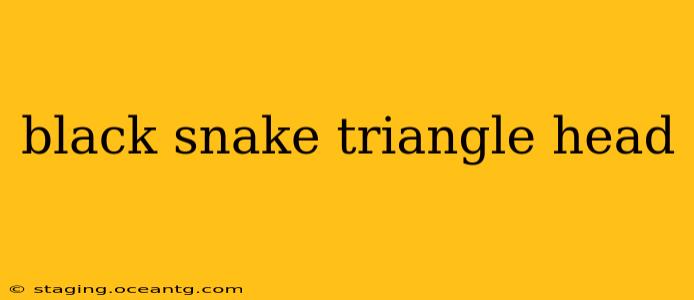The image of a black snake with a triangular head immediately conjures up thoughts of danger and venom. While the triangular head is a common characteristic of venomous pit vipers, it's crucial to understand that not all black snakes with this feature are venomous. This article will delve into the possible species, the myths surrounding them, and how to accurately identify these snakes to ensure safety.
What kind of snake has a black body and a triangle head?
Several snake species can exhibit a black body and a triangular-shaped head. The most likely candidates are venomous pit vipers, notably various species of rattlesnakes (Crotalus), copperheads (Agkistrodon contortrix), and cottonmouths (Agkistrodon piscivorus). However, the appearance can be deceiving. Some non-venomous snakes might also possess a head shape that appears triangular due to the way their muscles are positioned, especially when threatened. Therefore, relying solely on head shape for identification is extremely dangerous and unreliable.
Is a black snake with a triangular head venomous?
This is the crucial question. While a triangular head is a strong indicator of a venomous pit viper in North America, it's not a definitive identification marker. Some completely non-venomous snakes can exhibit a slightly triangular head shape, especially when they flatten their bodies for defense. Never attempt to handle a snake based solely on its appearance. Accurate identification requires careful observation of other characteristics like:
- Pupil shape: Pit vipers typically have elliptical or cat-like pupils.
- Heat-sensing pits: Located between the eyes and nostrils, these pits are a defining characteristic of pit vipers.
- Scales: The pattern and arrangement of scales vary significantly between species.
- Body markings: Look for bands, stripes, blotches, or other distinctive patterns.
- Geographic location: Knowing the snake's location significantly narrows down the possibilities.
How can I tell if a black snake is venomous?
Avoid handling any snake you suspect might be venomous. Instead, take a photograph from a safe distance and utilize field guides or online resources for identification, focusing on the features mentioned above. If you're unsure, contact a local wildlife agency, herpetologist, or animal control for assistance.
What are some common black snakes with triangular heads?
Identifying a snake solely based on color and head shape is unreliable and potentially dangerous. However, some common species that could fit this description include:
- Various Rattlesnake species: Many rattlesnake species exhibit dark coloration, including black phases, and the characteristic triangular head.
- Copperheads: While often copper-colored, some copperheads can appear very dark or even black.
- Cottonmouths: Also known as water moccasins, cottonmouths have a broad, triangular head and are often dark in color.
What should I do if I encounter a black snake with a triangular head?
Your safety is paramount. Maintain a safe distance, avoid sudden movements, and do not attempt to handle the snake. Carefully observe it from a distance to help with identification (photographing is helpful but don't get too close). If the snake is in a dangerous location (near a home, school, etc.), contact your local wildlife agency or animal control.
Disclaimer: This information is for educational purposes only. Never attempt to handle a snake you are unsure about. Always prioritize your safety and consult with experts for accurate identification and handling of potentially venomous snakes.
